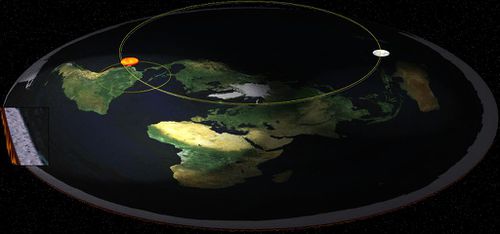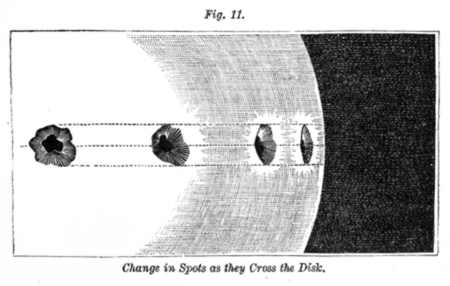Difference between revisions of "Sun"
(Earth is a sphere) Tags: Blanking Undo |
PeteSvarrior (talk | contribs) m (Reverted edits by 107.167.244.83 (talk) to last revision by Tom Bishop) Tag: Rollback |
||
| Line 1: | Line 1: | ||
| + | [[File:SarahSun2.gif|160px|right]]The '''Sun''' is a revolving sphere. It has a diameter of 32 miles and is located several thousand miles above the surface of the [[Earth]]. | ||
| + | ==Topics== | ||
| + | |||
| + | *'''[[Sunrise and Sunset]]''' - Sunrise and Sunset Main Page | ||
| + | :*'''[[Electromagnetic Acceleration]]''' describes the rising and setting of the Sun, as well as several other phenomena | ||
| + | :*'''[[The Setting of the Sun as a Perspective Effect]]''' describes the traditional interpretation of sunsets as originally described by [[Samuel Rowbotham]] | ||
| + | :*'''[[Magnification of the Sun at Sunset]]''' describes why the Sun does not shrink as it recedes | ||
| + | :*The '''[[Equinox]]''' page describes why the Sun rises and sets from a generally Eastward and Westward direction | ||
| + | *[[Temperature Variations]] of sunlight | ||
| + | *[[Distance to the Sun]] | ||
| + | *The [[Seasons]] | ||
| + | *[[Clouds Lit From Below]] | ||
| + | |||
| + | ==Spotlight effect== | ||
| + | |||
| + | The Sun's area of light is limited to an elliptic area of light upon the earth much like the light of a lighthouse is limited to a finite area around it. The rotating light on a lighthouse does not propagate infinitely into the distance. This means that only certain portions of the Earth are lightened at a time. It also describes how night and day arise on a Flat Earth. Over a large area of land light is limited in its extent due to various possible phenomena. See: '''[[Sunrise and Sunset]]''' | ||
| + | |||
| + | ===Rendered picture of the Sun in relation to the Earth=== | ||
| + | |||
| + | [[File:RenderedFE.jpg|500px]] | ||
| + | |||
| + | ==Sun Spherical== | ||
| + | |||
| + | Like the [[Moon]], the Sun is generally believed to be spherical. Evidence in favor of sphericity is the apparent change in the shape of sunspots as they approach the edge of the Sun's visible disk. | ||
| + | |||
| + | '''The Story of the Stars'''<br> | ||
| + | New Descriptive Astronomy<br> | ||
| + | Joel Dorman Steele, Ph.D., | ||
| + | |||
| + | [https://ufdc.ufl.edu/UF00053283/00001/58 The Solar System p.44] ([https://web.archive.org/web/20200306220646/https://ufdc.ufl.edu/UF00053283/00001/57 Archive]) | ||
| + | |||
| + | {{cite|Spots Apparently Change Their Speed and Form as They Pass Across the Disk — A spot is seen on the eastern limb; day by day it progresses, With a gradually-increasing rapidity, until it reaches the center; it then Slowly loses its rapidity, and finally disappears on the western limb. The diagram illustrates the apparent change which takes place in the form. Suppose at first the spot is of an oval shape; as it approaches the center it apparently widens and becomes circular. Having passed that point, it becomes more and more oval until it disappears.}} | ||
| + | |||
| + | [[File:Sunspots.png|450px]] | ||
| + | |||
| + | Dr. Dorman suggests that the Sun rotates: | ||
| + | |||
| + | {{cite|This Change in the Spots Proves the Sun’s Rotation on Its Axis — These changes can be accounted for only on the supposition that the sun rotates on its axis: indeed, they are the precise effects which the laws of perspective demand in that case. About twenty-seven days elapse from the appearance of a spot on the eastern limb before it is seen a second time.}} | ||
| + | |||
| + | [[Category:Cosmos]] | ||
| + | [[Category:Sun]] | ||
Latest revision as of 17:22, 15 October 2022
The Sun is a revolving sphere. It has a diameter of 32 miles and is located several thousand miles above the surface of the Earth.
Topics
- Sunrise and Sunset - Sunrise and Sunset Main Page
- Electromagnetic Acceleration describes the rising and setting of the Sun, as well as several other phenomena
- The Setting of the Sun as a Perspective Effect describes the traditional interpretation of sunsets as originally described by Samuel Rowbotham
- Magnification of the Sun at Sunset describes why the Sun does not shrink as it recedes
- The Equinox page describes why the Sun rises and sets from a generally Eastward and Westward direction
- Temperature Variations of sunlight
- Distance to the Sun
- The Seasons
- Clouds Lit From Below
Spotlight effect
The Sun's area of light is limited to an elliptic area of light upon the earth much like the light of a lighthouse is limited to a finite area around it. The rotating light on a lighthouse does not propagate infinitely into the distance. This means that only certain portions of the Earth are lightened at a time. It also describes how night and day arise on a Flat Earth. Over a large area of land light is limited in its extent due to various possible phenomena. See: Sunrise and Sunset
Rendered picture of the Sun in relation to the Earth
Sun Spherical
Like the Moon, the Sun is generally believed to be spherical. Evidence in favor of sphericity is the apparent change in the shape of sunspots as they approach the edge of the Sun's visible disk.
The Story of the Stars
New Descriptive Astronomy
Joel Dorman Steele, Ph.D.,
The Solar System p.44 (Archive)
“ Spots Apparently Change Their Speed and Form as They Pass Across the Disk — A spot is seen on the eastern limb; day by day it progresses, With a gradually-increasing rapidity, until it reaches the center; it then Slowly loses its rapidity, and finally disappears on the western limb. The diagram illustrates the apparent change which takes place in the form. Suppose at first the spot is of an oval shape; as it approaches the center it apparently widens and becomes circular. Having passed that point, it becomes more and more oval until it disappears. ”
Dr. Dorman suggests that the Sun rotates:
“ This Change in the Spots Proves the Sun’s Rotation on Its Axis — These changes can be accounted for only on the supposition that the sun rotates on its axis: indeed, they are the precise effects which the laws of perspective demand in that case. About twenty-seven days elapse from the appearance of a spot on the eastern limb before it is seen a second time. ”



